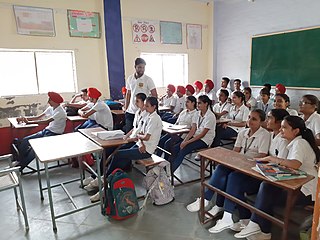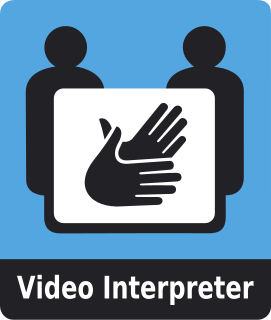Related Research Articles

British Sign Language (BSL) is a sign language used in the United Kingdom (UK), and is the first or preferred language among the Deaf community in the UK. Based on the percentage of people who reported 'using British Sign Language at home' on the 2011 Scottish Census, the British Deaf Association estimates there are 151,000 BSL users in the UK, of which 87,000 are Deaf. By contrast, in the 2011 England and Wales Census 15,000 people living in England and Wales reported themselves using BSL as their main language. People who are not deaf may also use BSL, as hearing relatives of deaf people, sign language interpreters or as a result of other contact with the British Deaf community. The language makes use of space and involves movement of the hands, body, face, and head.

Education in India is primarily managed by state-run public education system, which fall under the command of the government at three levels: Central, state and local. Under various articles of the Indian Constitution and the Right of Children to Free and Compulsory Education Act, 2009, free and compulsory education is provided as a fundamental right to children aged 6 to 14. The approximate ratio of public schools to private schools in India is 7:5.
Auslan is the majority sign language of the Australian Deaf community. The term Auslan is a portmanteau of "Australian Sign Language", coined by Trevor Johnston in the 1980s, although the language itself is much older. Auslan is related to British Sign Language (BSL) and New Zealand Sign Language (NZSL); the three have descended from the same parent language, and together comprise the BANZSL language family. Auslan has also been influenced by Irish Sign Language (ISL) and more recently has borrowed signs from American Sign Language (ASL).

Deaf culture is the set of social beliefs, behaviors, art, literary traditions, history, values, and shared institutions of communities that are influenced by deafness and which use sign languages as the main means of communication. When used as a cultural label especially within the culture, the word deaf is often written with a capital D and referred to as "big D Deaf" in speech and sign. When used as a label for the audiological condition, it is written with a lower case d. Carl G. Croneberg coined the term "Deaf Culture" and he was the first to discuss analogies between Deaf and hearing cultures in his appendices C/D of the 1965 Dictionary of American Sign Language.
Interpreting is a translational activity in which one produces a first and final translation on the basis of a one-time exposure to an expression in a source language.
The Registry of Interpreters for the Deaf, Inc (RID) is a non-profit organization, founded on June 16, 1964 and incorporated in 1972, that seeks to uphold standards, ethics, and professionalism for American Sign Language interpreters. The process of the founding of RID began with Dr. Boyce R. Williams, who worked for the Office of Vocational Rehabilitation. In a joint collaboration between Vocational Rehabilitation and the Department of Health, Education and Welfare (HEW), Dr. Williams, who was also Deaf, led the "Workshop on Interpreting for Deaf People," and RID was established during the workshop. RID is the only organization in the United States that credentials both Deaf and Hearing interpreters to provide services in a wide range of settings, as well as test and certify interpreters for legal work. The RID Board is committed to the "4 R's" which are: Roots, Respect, Relevance and Results. As of 2014 there were over 15,000 members and 58 affiliate chapters.
Kenyan Sign Language is a sign language used by the deaf community in Kenya and Somalia. It is used by over half of Kenya's estimated 600,000 deaf population. There are some dialect differences between Kisumu, Mombasa and Somalia.

A video relay service (VRS), also sometimes known as a video interpreting service (VIS), is a video telecommunication service that allows deaf, hard-of-hearing, and speech-impaired (D-HOH-SI) individuals to communicate over video telephones and similar technologies with hearing people in real-time, via a sign language interpreter.
Italian Sign Language or LIS is the visual language used by deaf people in Italy. Deep analysis of it began in the 1980s, along the lines of William Stokoe's research on American Sign Language in the 1960s. Until the beginning of the 21st century, most studies of Italian Sign Language dealt with its phonology and vocabulary. According to the European Union for the Deaf, the majority of the 60,000–90,000 Deaf people in Italy use LIS.

Video remote interpreting (VRI) is a videotelecommunication service that uses devices such as web cameras or videophones to provide sign language or spoken language interpreting services. This is done through a remote or offsite interpreter, in order to communicate with persons with whom there is a communication barrier. It is similar to a slightly different technology called video relay service, where the parties are each located in different places. VRI is a type of telecommunications relay service (TRS) that is not regulated by the FCC.

The Christian School and Chapel for the Deaf is a school located in Luquillo, Puerto Rico. It was named the Evangelical School for the Deaf (ESD) until its name change in 2011.

Deaf education is the education of students with any degree of hearing loss or deafness. This may involve, but does not always, individually-planned, systematically-monitored teaching methods, adaptive materials, accessible settings, and other interventions designed to help students achieve a higher level of self-sufficiency and success in the school and community than they would achieve with a typical classroom education. A number of countries focus on training teachers to teach deaf students with a variety of approaches and have organizations to aid deaf students.
Russian Sign Language is the sign language of the Deaf community in Russia and Tajikistan, and possibly in neighboring countries such as Belarus, Moldova, and Georgia. Russian Sign has a grammar unlike the Russian language, with much stricter word order and word formation rules. Russian Sign Language belongs to the French Sign Language family. Vocabulary from Austrian Sign Language also heavily influences Russian Sign Language.
Inuit Sign Language is an indigenous sign language. It is a language isolate native to Inuit communities in the Canadian Arctic. It is currently only attested within certain communities in Nunavut, particularly Baker Lake and Rankin Inlet. Although there is a possibility that it may be used in other places where Inuit people live in the Arctic, this has not been confirmed.
The sociolinguistics of sign languages is the application of sociolinguistic principles to the study of sign languages. The study of sociolinguistics in the American Deaf community did not start until the 1960s. Until recently, the study of sign language and sociolinguistics has existed in two separate domains. Nonetheless, now it is clear that many sociolinguistic aspects do not depend on modality and that the combined examination of sociolinguistics and sign language offers countless opportunities to test and understand sociolinguistic theories. The sociolinguistics of sign languages focuses on the study of the relationship between social variables and linguistic variables and their effect on sign languages. The social variables external from language include age, region, social class, ethnicity, and sex. External factors are social by nature and may correlate with the behavior of the linguistic variable. The choices made of internal linguistic variant forms are systematically constrained by a range of factors at both the linguistic and the social levels. The internal variables are linguistic in nature: a sound, a handshape, and a syntactic structure. What makes the sociolinguistics of sign language different from the sociolinguistics of spoken languages is that sign languages have several variables both internal and external to the language that are unique to the Deaf community. Such variables include the audiological status of a signer's parents, age of acquisition, and educational background. There exist perceptions of socioeconomic status and variation of "grassroots" deaf people and middle-class deaf professionals, but this has not been studied in a systematic way. "The sociolinguistic reality of these perceptions has yet to be explored". Many variations in dialects correspond or reflect the values of particular identities of a community.
Lou Fant was a pioneering teacher, author and expert on American Sign Language (ASL). He was also an actor in film, television, and the stage. Natively bilingual in ASL and English, he often played roles relating to sign language and the deaf.
Deaf Education in Kenya is a constantly changing section of the Kenyan education system that is focused on educating deaf, hard-of-hearing, and hearing-impaired Kenyan students. There are many organizations in Kenya made to protect the rights of Deaf Kenyans and promote progress in deaf education. The state of Kenyan deaf education is constantly changing and improving.
Language exposure for children is the act of making language readily available and accessible during the critical period for language acquisition. Deaf and hard of hearing children, when compared to their hearing peers, tend to face more hardships when it comes to ensuring that they will receive accessible language during their formative years. Therefore, deaf and hard of hearing children are more likely to have language deprivation which causes cognitive delays. Early exposure to language enables the brain to fully develop cognitive and linguistic skills as well as language fluency and comprehension later in life. Hearing parents of deaf and hard of hearing children face unique barriers when it comes to providing language exposure for their children. Yet, there is a lot of research, advice, and services available to those parents of deaf and hard of hearing children who may not know how to start in providing language.
American Sign Language (ASL) is a language that uses hand signs, facial expressions, and body postures to communicate ideas. ASL is a rich, complex language on par with spoken languages, and employs rules of phonology, syntax, morphology, etc. using manual/visual modes of communication, where spoken languages rely on the oral/aural modes of communication. ASL is used by Deaf and hard-of-hearing people in the North American continent, often as their primary language.

A Silent Agreement is a 2017 Australian romantic drama film written and directed by Davo Hardy. It was the first theatrically released, cinematic film to feature Auslan as both a main language of the film's dialogue, as well as a key plot element in the story.
References
- ↑ Florida Registry of Interpreters for the Deaf: About Us Checked on July 18, 2010